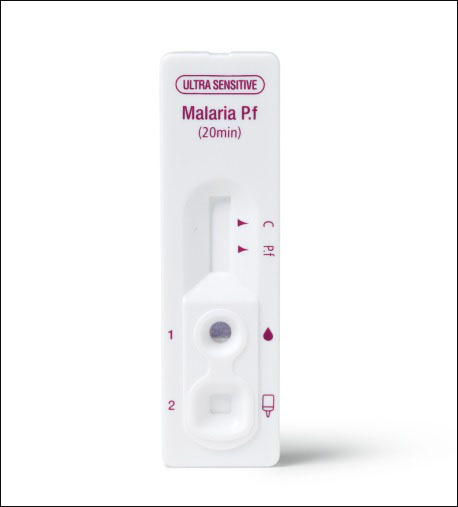 This article is more than 5 years old. Information may no longer be current.
This article is more than 5 years old. Information may no longer be current.
Alere launches first-ever rapid diagnostic test for asymptomatic malaria infection
Alere Inc. recently announced in a press release that the company has launched the first rapid diagnostic test that is sensitive enough to detect malaria infections among asymptomatic patients.
According to the company, the Alere Malaria Ag P.f improves the detection of histidine-rich protein II (HRP-II) antigen of Plasmodium falciparum by 10-fold compared with other currently available rapid tests and can identify patients with very low parasitemia who may not have apparent symptoms.
“Breaking the cycle of malaria transmission requires identifying all infected individuals, but until now, point-of-care diagnostic tests have not been sensitive enough to reliably detect asymptomatic infections,” Avi Pelossof, global president of infectious disease at Alere, said in the release. “The Alere Malaria AG P.f represents a game-changing tool to empower health care workers to identify asymptomatic individuals in even the most remote settings, contributing to a reduced malaria reservoir in communities — key strategies in eliminating this devastating disease.”
The Alere Malaria Ag P.f test can produce results from human whole blood samples within 20 minutes, the release said. It was granted the CE mark of approval in December 2016, and was evaluated during the WHO FIND Malaria RDT Evaluation Program.
Alere is working with the Bill & Melinda Gates Foundation, which supported the development of the device, as well as PATH and FIND to gather field data demonstrating the public health value of the test.
“We are excited by the potential for this product to address one of the barriers identified on the path to malaria eradication — the non-acute disease reservoir that complicates efforts to stop transmission,” Bruno Moonen, MD, MSc, deputy director of the malaria program at the Bill & Melinda Gates Foundation, said in the release. “Until now, we haven’t had a tool to tackle this challenge in low-transmission settings. Added to existing RDTs, prevention methods and treatments that reduce disease burden in high- and medium-transmission settings, this test will add a new tool to the fight against malaria.”
Disclosure:
Pelossof is an employee of Alere.
Perspective
Back to Top
John B. Dame, PhD

In low-transmission settings, the malaria infections detected by the current HRP-based RDTs for Plasmodium falciparum often represent only a small fraction of the malaria infections in the population. Reducing the limit of detection (LOD) of the HRP-based RDTs by 10-fold is an important step forward, and this new product should be capable of identifying a portion of these undiagnosed infections. Of some concern is the fact that the widespread use of HRP-based RDTs has resulted in the selection of P. falciparum lines lacking expression of HRP2 and HRP3. HRP-based RDTs are thus less reliable in some regions of the world. Parasites with hrp2/3 deletions have been reported in multiple countries, including Senegal, Mali and India, as well as in the western hemisphere in Colombia, Peru, Suriname and French Guiana. Novel diagnostic tests are needed that reliably detect infections with both HRP-positive and HRP-negative parasites, including asymptomatic, submicroscopic infections. The latter are rarely detected, because diagnostic methods designed to detect them have not been widely employed in the field, and the LOD required to reliably detect them is only now being explored.
References:
Abdallah JF, et al. Malar J. 2015;doi:10.1186/s12936-014-0537-7.
Bharti PK, et al. PLoS One. 2016;doi:10.1371/journal.pone.0157949.
Bousema T, et al. Nat Rev Microbiol. 2017;doi:10.1038/nrmicro3364.
Deme AB, et al. Malar J. 2014;doi: 10.1186/1475-2875-13-34.
Dorado EJ, et al. PLoS One. 2016;doi:10.1371/journal.pone.0163137.
Elbadry MA, et al. Malar J. 2015;doi:10.1186/s12936-015-1051-2.
Gamboa D, et al. PLoS One. 2010;doi:10.1371/journal.pone.0008091.
Harris I, et al. Malar J. 2010;doi: 10.1186/1475-2875-9-254.
Koita OA, et al. Am J Trop Med Hyg. 2012;doi:10.4269/ajtmh.2012.10-0665.
Kumar N, et al. Acta Trop. 2013;doi:10.1016/j.actatropica.2012.09.015.
Okoth SA, et al. PLoS One. 2015;doi:10.1371/journal.pone.0126805.
Raccurt CP, et al. Bull Soc Pathol Exot. 2014;doi:10.1007/s13149-014-0391-4.
Raccurt CP, et al. Bull Soc Pathol Exot. 2015;doi:10.1007/s13149-014-0367-4.
Solano CM, et al. PLoS One. 2015;doi:10.1371/journal.pone.0131576.
Trouvay M, et al. PLoS One. 2013;doi:10.1371/journal.pone.0074269.
John B. Dame, PhD
Professor and chair, department of infectious diseases and pathology
University of Florida
Disclosures: Dame reports no relevant financial disclosures.


